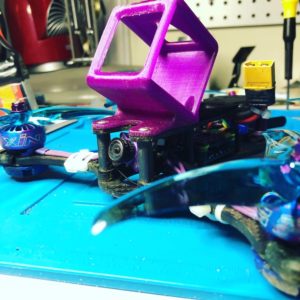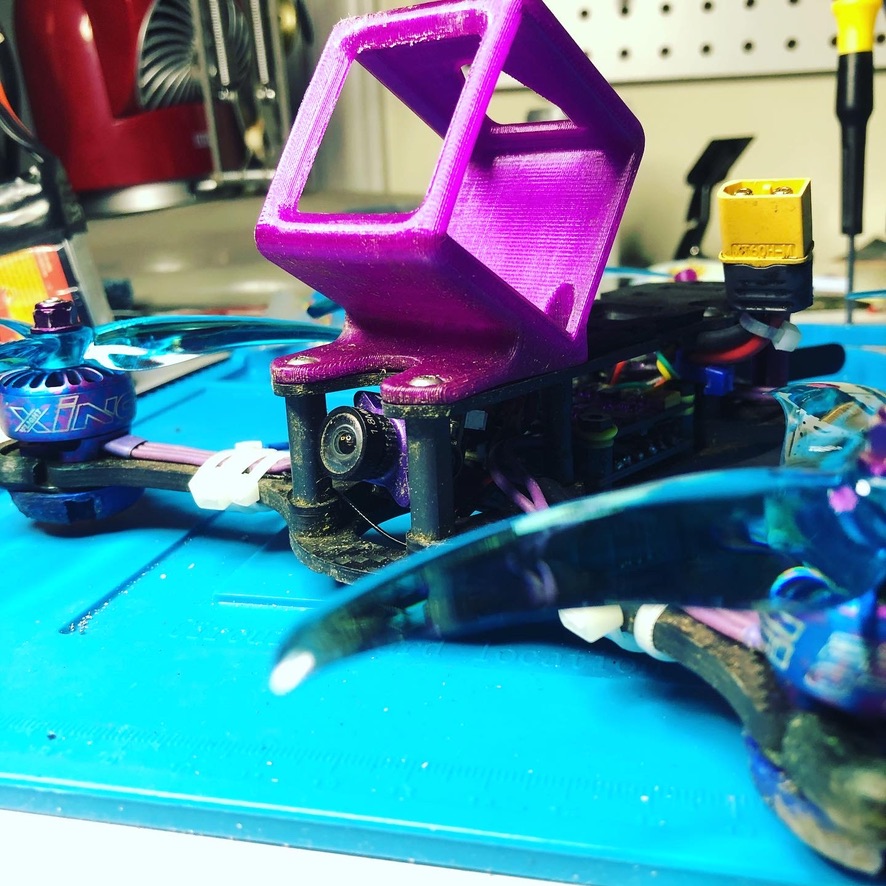This is for those wanting to take their first steps into the hobby. It is not intended to be an end-all-be-all as the domain for it all is quite expansive. With that, ready to strap your consciousness in a robot that can fly? Let’s have a chat about FPV (first-person-view) multicopters (multiple rotors that lift an aircraft).
I disclaim that I’m still a plebeian when it comes to this field. Starting in May of 2019 with the help of a good friend I have learned quite a lot and am constantly being asked questions by others so I promised to write up a resource document on getting started.
As a lifelong learner, this field is exceptionally deep and talent diverse. Know that you will not know it all, but knowing good people that know more than you is key to having a good time whether you are flying, repairing, or pondering your next build.

Build, Fly, Crash, Repeat
You’re going to have problems. You are going to crash. You will likely start a fire at some point. You will have many oh-sh*t moments. You will spend a small fortune getting started, and if not careful, staying aloft. Caveat emptor.
You will also have the most fun you may have ever had. Feel the freedom that is only associated with skydivers and pilots. Laugh deeply at some of the crazy stunts you will pull off. And most definitely get to reflect upon your day by rewinding some HD footage by yourself, or hopefully with some good mates.
Are you cool with all that? Let’s begin.
Multidisciplinary Hobby
While you can get started for relatively cheaply, know that to make the most of this hobby you’re going to be picking up some skills you may or may not have. To build, you will be assembling motors, ESC boards, flight controllers, cameras, radios—so general assembly through mildly specialized tools you may not have on hand (hex/m4/m5), soldering, smoke-stopper power testing, logic board to computer testing, motor p-i-d tuning, general flight board configuration.
It sounds like a lot, and it is, but if you can assemble an IKEA dresser, you can probably handle this. It’s just lots of littles, testing, flight testing, and revisions. To fly, you’re going to fly simulators before doing the real thing, then going under some goggles for the FPV element, configuring a radio controller (LUA coder if you want to get deep) with a lot of potential switches, and flying outside of your body—oh and coming back (right?!) You’ll be testing motors, prop directions, how your tuning responds to your inputs, and a lot of iterations. Did I mention the invariable “um, what is going on” moments because you’re flying homebrew tech that will inevitably have a gremlin that may or may not be troubleshot easily.
I know, lots of concepts and new words above. Don’t worry. It’s meant to push the sandbox of your brain open with a bulldozer so we can build in it appropriately.
Start with a Simulator
I cannot, cannot, cannot, express this enough. Start with simulations. We live in a modern age with computers that can calculate pretty darn good physics, so use the tools before us to help build your mental map and hand-eye coordination that will be needed for your first real flights. Not to mention it’s a lot cheaper than wrecking a $200+ quad in the side of your house or having a fly-away that is never to be heard from again.
There may be more but these are the two most popular and so very well-honed:
A while back Liftoff held the grand title but as I understand it Velocidrone has come a long way and is highly competitive, even more so if you are heading into MultiGP. I picked up Liftoff first because some of the videos I was watching liked it and via Steam community tied tutorials into home-built maps worked well. I’m now starting in on Velocidrone because our local GP guys are building maps and that’s pretty cool in itself.
You can start with either of these and if you’re like most of us, you own a game controller from an Xbox or a Playstation. You can use both through your computer and get started ASAP.
Caveat: If you do this the piece to remember and remember well is that a game controller pulls you back to the center of the joystick where your real radio controller will not. If it’s an old controller you can open it up and remove a tension spring that does this or just get your feet wet today and deal with the retraining as soon as you pick up a real controller.
Speaking of a radio controller, pick up a Taranis Q X7 and battery. It’s got enough channels for you to do a lot with, will scale over time, can run an open software called OpenTX, can plug via USB or dongle up to your computer to run sims, store profiles for your future fleet, etc, etc, etc.
If you pick up a radio and have a simulator, you are good to get started. Train, practice, experiment, watch videos, hone yourself. By the time you go to your next step, you will be much farther along and the risk of your first flight is mitigated by a lot.
Getting Started Quickly—a Bind and Fly
Two pieces of this equation to get started. You need something to look from and you need a device to fly. Currently, I don’t think people should be builders. You’ve simulated, you need something real world, and after the real world, you’re going to make a critical decision on whether to become a pilot with a fleet or that this just wasn’t for you. Better to keep your investments to a minimum to test the waters because if you dive in it is deep.
A bind and fly, also known as a BnF, is a fully operational quadcopter that just needs to be bound to a remote. There is another class of pre-builts called ready-to-fly (RtF) that is everything but the radio on-board the copter. Getting an RtF will require soldering so let’s avoid that for the moment.
What kind of BnF should you pick up? A Tiny Whoop. No question. They are 3″ large, usually wrapped in a plastic housing and can be flown indoors or outdoors (pretend I didn’t say indoors until you get better, lol.) Oscar Liang (which is a resource to remember) has a good breakdown on tiny whoops and it’s worth reading. I’d recommend the TinyHawk, Mobula7, or the Beta75 as a good one to pick up. They are all qualitative. They each can take a beating and will have longevity in your future fleet for just fun, to pass down to your kids, or have other kids fly if the teacher in you eventually comes out. Did I mention you can also run these right into others and everyone will be ok? Not a bad place to start.
If you’re like me, you’ll get your kids to chase it and you’ll use avoiding them to train you in collision avoidance, object orbiting, and many other acrobatic maneuverings which will translate to your future 5″.
Goggles, now this is a tricky decision. You can get a full BnF kit that comes with a radio, a breadbox goggle, and a Tinyhawk for relatively cheap. There are also other kits, and places that have offerings…
A Step Back, Expense Breakdown
Every endeavor has its cost. I’m not going to go all excel here, you can do that. Here are the pieces to the puzzle:
- Quadcopter (and all its myriad of parts)
- Radio Transmitter
- Goggles
- Potential, and Probable Repair Costs (have spares!)
A quad can run anywhere from $80-$350 (and far higher if you go long-range or install gimbals, or go Xclass—but $350 would put amazing parts in a 3″ through 5″ with spares.
Transmitters can run as cheap as $80 to $400. The breakdown will come down to channels you can control (things you can assign switches to or reroute information), built-in LCD panels for information or video relay, and form factor. Most transmitters you can also mod to put better (see smoother) gimbals, 900mhz modules, and other sundries. Again, the Taranis QX 7 has a lot of flexibility in its offering, growth, and cost.
Goggles, a very diverse set of answers these days. $100 to $600. Quite a spectrum, right? Build quality, receiver diversity, breadbox (one screen) vs binocular, field-of-view (30′-55+’), signal interpolation potential, LED vs OLED… Oh, and now DJI has entered the FPV fray, so even more cost and concepts. I started with some hand-me-down old Eachines that basically had a monocular vision (supposed to be binocular, hah!) My first upgrade was to the Fat Shark Attitude V5‘s which was a world of difference in quality. Now I’ve funded the Orqa’s Kickstarter project as a step up into the big leagues. The main reason for picking up two for myself was so I can have Logan in training as a ride-along and for his own use. Otherwise, I’d just sell the V5’s and pick up an external screen for people to pass around while I fly.
Your transmitter and goggle selection will be your main sunk cost. If you were to start and want to buy everything yourself out of the gate, you’d need around $300 in goggle + radio transmitter monies, and then your quadcopter running you a total of $400-$600. That’s a tough financial nut to crack not knowing if you even want to walk the path. On the other hand, spending $160 for a little Tinyhawk, radio, and goggles, knowing it’s kind of disposable or hand-me-down material at least gets you in the game without feeling way out of pocket. Then you can both reuse and replace most of the equipment in that bundle over time (check out this RTF review of the EMax).
Going back to investments, it’s always nice to know that a radio can be used to fly fixed wings (planes) to cars. They also hold their value pretty well for resale. The better the goggles, you can feed HDMI in and use them as another screen for whatever your pleasure. Just meaning as you pick up more qualitative parts, they have multiple uses over time which, to my money brain, makes the amortization of the investments travel farther out.
You do you!
This is all just a quick start guide to getting your feet wet. If you wish to follow Alice and ‘drink this’, then you can certainly go down far, learn, apply, and fly some interesting creations. If this has inspired you, fantastic. Here are some additional resources to get you moving. If you need help, reach out to me, and I’ll help how I can or direct you to more resources where I can.
Community Resources
- Reddit (/r/multicopterbuilds, /r/quadcopter, /r/fpv)
- RC Groups
- Radiocontrol/Multicopter Discord
- RotorBuilds (my first build)
Education (YouTube)
- Bardwell (and his site FPV Know It All <–great tool resource)
- Oscar Liang
- FPV Academy
- RotorRiot
- Know Before You Fly (rules are important!)
Equipment, Software, Shopping
- BetaFlight
- Open-TX
- Foxeer
- GetFPV
- Raceday Quads
- Banggood
- iFlight
- eMax
- Shendrones
- Fatshark, Orqa, eachine
- ..just touching the surface..
Friends & Skilled Pilots (YouTube)
- Mine! (Not skilled, but fun to see what I’m up to.)
- Nurk (Racer, Builder, Cinestyle)
- FPV Jesus (Local Friend)
- FPV Dreams (Local Friend)
- FPV Dreams (Local Friend)
- Mactac (Canadian Long Range)
- Jean-Quad Van Ham (Local Friend)
- Cricket (Georgia Pilot of >Skill)
- and so many more… really, lots of great people out there.
Blue skies!

